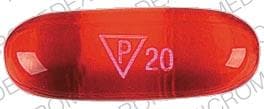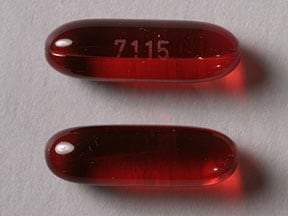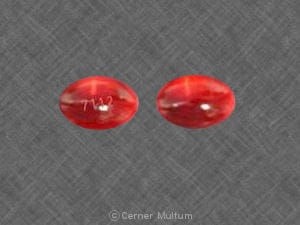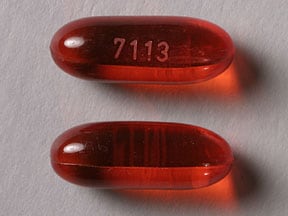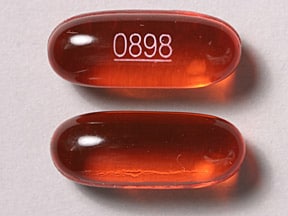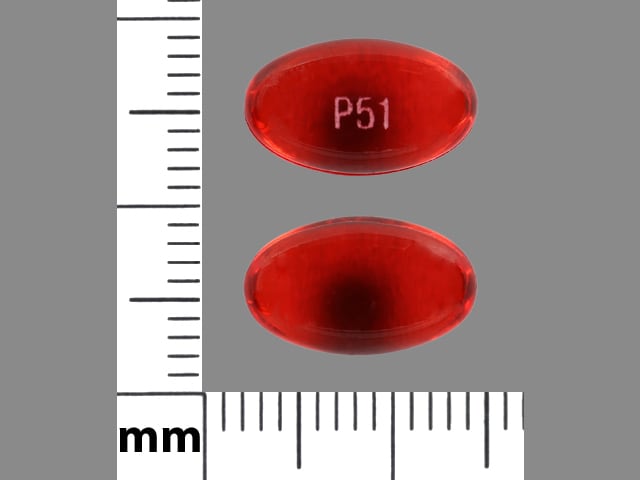Dosage Forms
Excipient information presented when available (limited, particularly for generics); consult specific product labeling. [DSC] = Discontinued product
Capsule, Oral, as calcium:
Kao-Tin: 240 mg [sodium free; contains brilliant blue fcf (fd&c blue #1), fd&c red #40, fd&c yellow #6 (sunset yellow)]
Stool Softener: 240 mg [contains brilliant blue fcf (fd&c blue #1), fd&c red #40, fd&c yellow #6 (sunset yellow)]
Generic: 240 mg
Capsule, Oral, as sodium:
Colace: 100 mg [contains fd&c red #40, fd&c yellow #6 (sunset yellow)]
Colace Clear: 50 mg [DSC] [dye free]
DocQLace: 100 mg [DSC] [contains fd&c red #40, fd&c yellow #6 (sunset yellow)]
Docu Soft: 100 mg
Docusil: 100 mg
DOK: 100 mg, 250 mg [contains fd&c red #40, fd&c yellow #6 (sunset yellow)]
Dulcolax Stool Softener: 100 mg [contains fd&c red #40, fd&c yellow #6 (sunset yellow)]
GoodSense Stool Softener: 100 mg [DSC] [gluten free; contains fd&c red #40, fd&c yellow #6 (sunset yellow)]
KS Stool Softener: 100 mg [stimulant free; contains brilliant blue fcf (fd&c blue #1), fd&c red #40, methylparaben, propylparaben, tartrazine (fd&c yellow #5)]
Laxa Basic: 100 mg
Sof-Lax: 100 mg [DSC]
Stool Softener: 100 mg
Stool Softener: 100 mg [contains fd&c red #40, fd&c yellow #10 (quinoline yellow), fd&c yellow #6 (sunset yellow)]
Stool Softener: 100 mg [contains fd&c red #40, fd&c yellow #6 (sunset yellow)]
Stool Softener: 100 mg [stimulant free; contains brilliant blue fcf (fd&c blue #1), fd&c red #40, fd&c yellow #6 (sunset yellow)]
Stool Softener: 100 mg, 250 mg [stimulant free; contains fd&c red #40, fd&c yellow #6 (sunset yellow)]
Generic: 100 mg, 250 mg
Enema, Rectal, as sodium:
Docusate Mini: 283 mg (5 mL)
DocuSol Kids: 100 mg/5 mL (5 ea) [contains polyethylene glycol]
DocuSol Mini: 283 mg (5 ea)
Enemeez Mini: 283 mg (5 mL)
Liquid, Oral, as sodium:
Diocto: 50 mg/5 mL (473 mL [DSC]) [contains fd&c red #40, methylparaben, polyethylene glycol, propylene glycol, propylparaben; vanilla flavor]
Diocto: 50 mg/5 mL (473 mL) [contains parabens, polyethylene glycol]
Docu: 50 mg/5 mL (10 mL, 473 mL) [contains methylparaben, polyethylene glycol, propylene glycol, propylparaben, sodium benzoate; vanilla flavor]
Pedia-Lax: 50 mg/15 mL (118 mL) [contains edetate disodium, methylparaben, polyethylene glycol, propylene glycol, propylparaben; fruit punch flavor]
Silace: 150 mg/15 mL (473 mL) [lemon-vanilla flavor]
Generic: 50 mg/5 mL (10 mL); 150 mg/15 mL (473 mL)
Syrup, Oral, as sodium:
Diocto: 60 mg/15 mL (473 mL [DSC]) [contains fd&c red #40, menthol, methylparaben, polyethylene glycol, propylparaben, sodium benzoate; peppermint flavor]
Diocto: 60 mg/15 mL (473 mL) [contains fd&c red #40, propylene glycol, saccharin sodium, sodium benzoate]
Silace: 60 mg/15 mL (473 mL) [contains alcohol, usp; peppermint flavor]
Generic: 60 mg/15 mL (25 mL)
Tablet, Oral, as sodium:
Docuprene: 100 mg [DSC] [contains sodium benzoate]
DOK: 100 mg
DOK: 100 mg [DSC] [scored]
Healthy Mama Move It Along: 100 mg [scored; stimulant free; contains sodium benzoate]
Promolaxin: 100 mg [scored; contains sodium benzoate]
Stool Softener: 100 mg [contains sodium benzoate]
Generic: 100 mg
Pharmacology
Mechanism of Action
Reduces surface tension of the oil-water interface of the stool resulting in enhanced incorporation of water and fat allowing for stool softening (Roering, 2010)
Pharmacokinetics/Pharmacodynamics
Excretion
Feces (Gattuso 1994)
Onset of Action
Oral: 12 to 72 hours; Rectal: 2 to 15 minutes
Use: Labeled Indications
Stool softener: Prevention of straining during defecation and constipation associated with hard, dry stools; relief of occasional constipation
Use: Off Label
Ceruminolyticb
Data from a small, prospective, randomized, double-blind controlled study comparing the intra-aural use of docusate to triethanolamine polypeptide (not available in the US) and subsequent irrigation with lukewarm normal saline as needed supports the use of docusate intra-aurally as a ceruminolytic Singer 2000. Despite these data, the use of saline is still considered to be first-line McCarter 2007. Additional trials may be necessary to further define the role of intra-aural docusate in the treatment of this condition.
Contraindications
OTC labeling: When used for self-medication, do not use for longer than 7 days; when abdominal pain, nausea, or vomiting is present; or concomitantly with mineral oil (oral products only)
Dosage and Administration
Dosing: Adult
Note: The following are general dosing guidelines; refer to specific product labeling for dosing instructions.
Stool softener:
Oral:
Docusate calcium: 240 mg once daily
Docusate sodium: 50 to 360 mg once daily or in divided doses
Rectal: 283 mg per 5 mL: 283 mg (1 enema) 1 to 3 times daily
Ceruminolytic (off-label use): Intra-aural: Administer 1 mL of docusate sodium in 2 mL syringes; if no clearance in 15 minutes, irrigate with 50 or 100 mL lukewarm normal saline (Singer 2000)
Dosing: Geriatric
Refer to adult dosing.
Dosing: Pediatric
Constipation (occasional), treatment; stool softener:
Docusate sodium:
Oral:
Manufacturer's labeling:
Children 2 years to <12 years: 50 to 150 mg/day in single or divided doses
Children ≥12 years and Adolescents: 50 to 360 mg/day in single or divided doses
Alternate dosing:
Weight-directed dosing: Infants and Children: 5 mg/kg/day in 1 to 4 divided doses (Nelson 1996)
Age-directed (fixed) dosing:
Infants ≥6 months and Children <2 years: 12.5 mg 3 times daily (NICE 2010)
Children ≥2 and Adolescents: 40 to 150 mg/day in 1 to 4 divided doses (Kliegman 2011); in children ≥12 years and adolescents, doses up to 500 mg/day divided may be used (NICE 2010)
Rectal:
Children 2 to <12 years:
100 mg/5 mL: 100 mg (1 unit) once daily
283 mg/5 mL: 283 mg (1 unit) once daily
Children ≥12 years and Adolescents: 283 mg/5mL: 283 mg (1 unit) 1 to 3 times daily
Docusate calcium: Children ≥12 years and Adolescents: 240 mg once daily
Administration
Oral: Administer as a single daily dose or in divided doses; ensure adequate fluid intake. Mix docusate liquid (50 mg per 5 mL) with milk or fruit juice to prevent throat irritation.
Rectal: For rectal use only. Lubricate tip prior to insertion by placing a few drops of the liquid from the enema on the shaft prior to insertion; may also apply a few drops of enema contents or lubricant to the anus prior to insertion. Gently insert lubricated applicator tip into rectum. Grasp bottle firmly and squeeze slowly to empty the contents. Discard after administration.
Dietary Considerations
Some products may contain sodium.
Storage
Store at room temperature. Protect from freezing, heat humidity, and light.
Docusate Images
Drug Interactions
There are no known significant interactions.
Adverse Reactions
1% to 10%: Respiratory: Throat irritation (liquid)
Warnings/Precautions
Dosage forms specific issues:
- Benzyl alcohol and derivatives: Some dosage forms may contain sodium benzoate/benzoic acid; benzoic acid (benzoate) is a metabolite of benzyl alcohol; large amounts of benzyl alcohol (≥99 mg/kg/day) have been associated with a potentially fatal toxicity (“gasping syndrome”) in neonates; the “gasping syndrome” consists of metabolic acidosis, respiratory distress, gasping respirations, CNS dysfunction (including convulsions, intracranial hemorrhage), hypotension and cardiovascular collapse (AAP 1997; CDC 1982); some data suggests that benzoate displaces bilirubin.
- Enema: For rectal use only; lubricate tip prior to insertion. Discontinue use and notify health care provider if rash around the anus/rectal irritation occurs or if resistance is encountered with insertion; forcing the tube may result in injury or damage to the rectum.
Other warnings/precautions:
- Self-medication (OTC use): When used for self-medication (OTC), patients should be instructed to contact healthcare provider prior to use if nausea, stomach pain, or vomiting are present, or if a sudden change in bowel habits occurs and persists over 14 days. Patients should discontinue use and notify healthcare provider if rectal bleeding occurs, if a bowel movement fails to occur after use, or if use is needed >7 days.
Monitoring Parameters
Rectal: Periodic rectal exams are recommended in patients with impaired rectal function, especially loss of sensation.
Pregnancy
Pregnancy Considerations
Hypomagnesemia was reported in a newborn following chronic maternal overuse of docusate sodium throughout pregnancy (Schindler 1984). Treatment of constipation in pregnant women is similar to that of nonpregnant patients and medications may be used when diet and lifestyle modifications are not effective. Agents other than docusate are preferred for initial treatment. Docusate sodium may be used if needed, but may not be as effective as other agents (ACG [Christie 2007]).
Patient Education
What is this drug used for?
- It is used to treat constipation.
Frequently reported side effects of this drug
- Abdominal cramps
Other side effects of this drug: Talk with your doctor right away if you have any of these signs of:
- Rectal irritation
- Signs of a significant reaction like wheezing; chest tightness; fever; itching; bad cough; blue skin color; seizures; or swelling of face, lips, tongue, or throat.
Note: This is not a comprehensive list of all side effects. Talk to your doctor if you have questions.
Consumer Information Use and Disclaimer: This information should not be used to decide whether or not to take this medicine or any other medicine. Only the healthcare provider has the knowledge and training to decide which medicines are right for a specific patient. This information does not endorse any medicine as safe, effective, or approved for treating any patient or health condition. This is only a brief summary of general information about this medicine. It does NOT include all information about the possible uses, directions, warnings, precautions, interactions, adverse effects, or risks that may apply to this medicine. This information is not specific medical advice and does not replace information you receive from the healthcare provider. You must talk with the healthcare provider for complete information about the risks and benefits of using this medicine.
